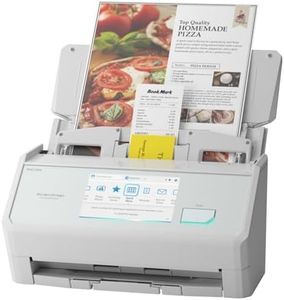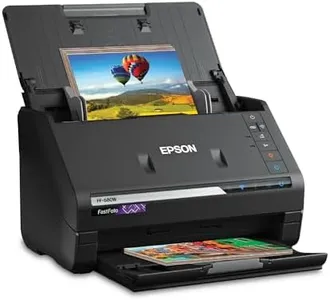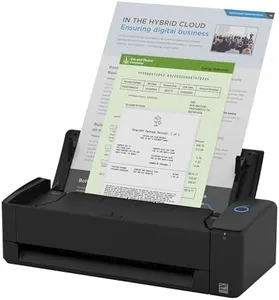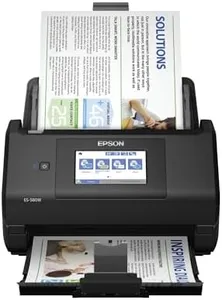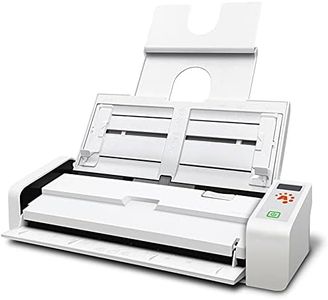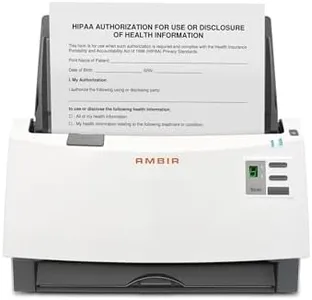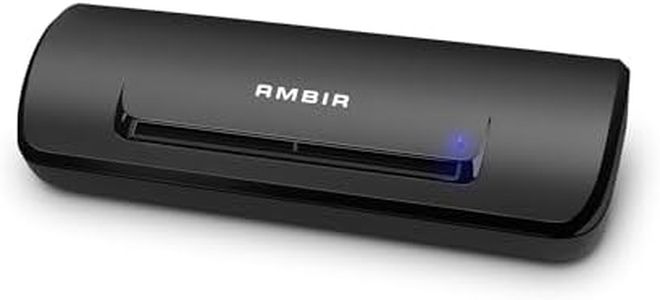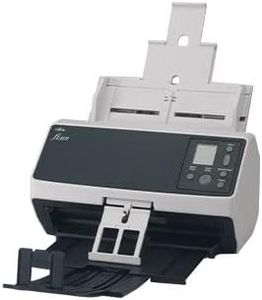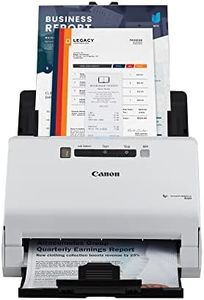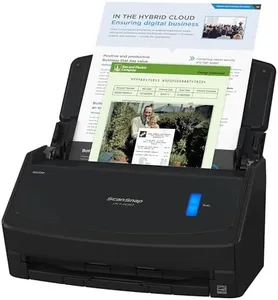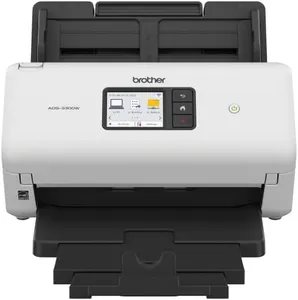10 Best High Speed Document Scanner 2025 in the United States
Our technology thoroughly searches through the online shopping world, reviewing hundreds of sites. We then process and analyze this information, updating in real-time to bring you the latest top-rated products. This way, you always get the best and most current options available.

Our Top Picks
Winner
ScanSnap iX2500 Wireless or USB High-Speed Cloud Enabled Document, Photo & Receipt Scanner with Large 5" Touchscreen and 100 Page Auto Document Feeder for Mac or PC, White
Most important from
4815 reviews
The ScanSnap iX2500 is a solid choice if you're looking for a high-speed document scanner that handles a variety of paper types smoothly. It scans double-sided pages quickly at 45 pages per minute, which is excellent for busy offices or anyone needing to digitize large volumes efficiently. The 100-sheet automatic document feeder (ADF) means you can load plenty of papers at once, reducing the need for constant refills. With a sharp 600 dpi resolution, it captures clear images for documents, photos, and receipts, suitable for most typical business and personal scanning needs.
This model’s standout feature is its large 5-inch touchscreen, making it easy to select customized scanning profiles and quickly send files to your computer, mobile device, or cloud service—a big help if you frequently scan to multiple destinations. Connectivity is versatile with both USB-C and Wi-Fi 6, allowing stable and fast wireless scanning without a computer. The scanner also includes smart paper handling features like a brake roller system and multi-feed sensors that help prevent jams and paper damage, which can save time and frustration. On the software side, it offers automatic optimization, file naming, and sorting, so managing scanned files is straightforward.
Weighing 7.7 pounds and fairly compact, it is best suited for users who want a dependable scanner for office or home use rather than on-the-go portability. If you need ultra-high resolution scans or specialized color accuracy for professional photo work, this might not be the perfect fit. For general document, receipt, and photo scanning with ease and speed, the ScanSnap iX2500 covers all the key bases well.
Most important from
4815 reviews
RICOH fi-8170 Professional High Speed Color Duplex Document Scanner - Network Enabled
Most important from
150 reviews
The RICOH fi-8170 is a high-speed document scanner that stands out for its impressive scanning speed of up to 70 double-sided pages per minute. This makes it an excellent choice for busy offices or individuals who need to digitize large volumes of documents quickly. The scanner's ability to handle various document types, including thick items like passports and ID cards, adds to its versatility. With a resolution of 600 DPI, it ensures high-quality image capture, allowing for clear, accurate scans.
One of the strong features is the included PaperStream Capture software, which simplifies the scanning process, making it user-friendly for those who may not be tech-savvy. Moreover, the integration capabilities with most enterprise content management (ECM) solutions via USB or Ethernet make it a practical option for businesses looking to streamline their document management.
There are some weaknesses to consider. While its scanning speed is quick, the scanner weighs 8.8 pounds and has a compact design, which may not suit everyone looking for a portable scanner.
Most important from
150 reviews
Epson FastFoto FF-680W Wireless High-Speed Photo and Document Scanning System, Black
Most important from
3159 reviews
The Epson FastFoto FF-680W is designed to stand out in the high-speed document scanner market, especially for those looking to scan photos and documents quickly. One of its biggest strengths is its impressive scanning speed, with the capability of scanning up to 1 photo per second at 300 dpi and up to 45 pages per minute for documents. This is perfect for users who want to digitize large quantities of items efficiently.
With a resolution of 600 dpi, it offers clear and detailed scans, making it suitable for preserving family photos or important documents. Its Automatic Document Feeder (ADF) can hold up to 36 photos or documents at once, further enhancing productivity. The FastFoto FF-680W also excels in versatility, allowing users to scan various formats, including Polaroids and postcards, while its duplex scanning feature means it can scan both sides of a page simultaneously. It’s equipped with useful software like Epson ScanSmart, which includes OCR capabilities, enabling scanned documents to be converted into editable text.
On the connectivity front, it provides easy options with both USB and wireless capabilities, allowing it to be placed conveniently in your workspace. The ability to auto-upload scanned items to cloud services like Dropbox and Google Drive is a modern convenience. There are some drawbacks to consider. While it performs well with photos, users might find that it is slightly less effective with thicker documents, which could require a bit of manual adjustment. Additionally, while the scanner is relatively compact, it is still a bit bulky for those with limited desk space. Also, some users have reported that the software could be more user-friendly, as it might take some time to master all functions.
The Epson FastFoto FF-680W serves as a reliable high-speed scanner, particularly for photos and documents, but it is important to be aware of its limitations when dealing with thicker materials.
Most important from
3159 reviews
Buying Guide for the Best High Speed Document Scanner
Choosing the right high-speed document scanner can significantly improve your productivity, whether for personal use or in a professional setting. The key is to understand the various specifications and how they align with your specific needs. By focusing on the most important features, you can ensure that you select a scanner that meets your requirements efficiently and effectively.FAQ
Most Popular Categories Right Now
